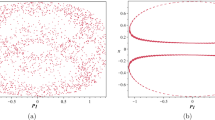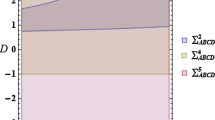Abstract
Using averaging theory, the existence of periodic solutions is established for an axially symmetric galaxy model described by a Hamiltonian endowed with a three-dimensional potential of two Miyamoto disks galaxies rotating around its z-axis.
Similar content being viewed by others
References
S. Aarseth, Gravitational N-body simulations (Cambridge University Press, Cambridge, 2003)
D. Barros, J. Lepine, W. Dias, Models for the 3-d axisymmetric gravitational potential of the milky way galaxy—a detailed modelling of the galactic disk. Astron. Astrophys. 593, 07 (2016)
A. Buică, J.-P. Françoise, J. Llibre, Periodic solutions of nonlinear periodic differential systems with a small parameter. Commun. Pure Appl. Anal. 6(1), 103–111 (2007)
R.G. Carlberg, K.A. Innanen, Galactic chaos and the circular velocity at the sun. Astron. J. 94(1), 666–670 (1987)
M. Katsanikas, P. Patsis, G. Contopoulos, The structure and evolution of confined tori near a Hamiltonian hopf bifurcation. Int. J. Bifurc. Chaos Appl. Sci. Eng. 21, 11 (2011)
M. Katsanikas, P.A. Patsis, The orbital behavior at the neighborhood of stable periodic orbits in a 3d galactic potential, in Proceedings of the 9th International Conference of the Hellenic Astronomical Society, Proceedings of a Conference held 20–24 September 2009 in Athens, Greece, ed. by K. Tsinganos, D. Hatzidimitriou, T. Matsakos (Astronomical Society of the Pacific, San Francisco, 2010), p. 380
M. Katsanikas, P.A. Patsis, The structure of invariant tori in a 3D galactic potential. Int. J. Bifurc. Chaos Appl. Sci. Eng. 21(2), 467–496 (2011)
J. Llibre, C. Vidal, Periodic motion in non-axially symmetric galaxies. J. Geom. Phys. 140, 1–9 (2019)
I.G. Malkin, Some Problems of the Theory of Nonlinear Oscillations (Gosudarstv. Izdat. Tehn.-Teor. Lit, Moscow, 1956). (Russian)
M. Miyamoto, R. Nagai, Three-dimensional models for the distribution of mass in galaxies. Publ. Astron. Soc. Jpn. 27(4), 533–543 (1975)
M. Roseau, Vibrations Non Linéaires et Théorie de la Stabilité (French). Springer Tracts in Natural Philosophy, vol. 8 (Springer, Berlin, 1966)
J.A. Sanders, F. Verhulst, J. Murdock, Averaging Methods in Nonlinear Dynamical Systems. Applied Mathematical Sciences, vol. 59, 2nd edn. (Springer, New York, 2007)
Ch. Skokos, P.A. Patsis, E. Athanassoula, Orbital dynamics of three-dimensional bars - i. the backbone of three-dimensional bars: a fiducial case. Mon. Not. Astron. Soc. 333(4), 847–860 (2002)
E. Zotos, N.D. Caranicolas, Order and chaos in a new 3D dynamical model describing motion in non-axially symmetric galaxies. Nonlinear Dyn. 74(4), 1203–1221 (2013)
Acknowledgements
The authors would like to express their warmest thanks to the anonymous referees for the careful reading of the manuscript and for the comments which allowed us to improve both the quality and the clarity of the paper. M. Alvarez-Ramírez is partially supported by Programa Especial de Apoyo a la Investigación de UAM (México) Grant Number I5-2019. J. D. García-Saldaña is supported by FONDECyT Grant Number 11171115.
Author information
Authors and Affiliations
Corresponding author
Ethics declarations
Conflict of interest
The authors declare no conflict of interest in preparing this article.
Appendix: Averaging theory
Appendix: Averaging theory
In this section, we shall present a basic result from averaging theory that we need for proving the results in this paper. The key tool is to provide an algorithm that computes periodic orbits based on averaging theory for Hamiltonian differential systems.
To attain this aim, we focus our attention to the problem of existence of T-periodic orbits for the differential system
for \(\varepsilon \) positive and small enough, where \(F_0,F_1:{\mathbb {R}}\times \Omega \rightarrow {\mathbb {R}}^n\) and \(F_2:{\mathbb {R}}\times \Omega \times (-\varepsilon _0,\varepsilon _0)\rightarrow {\mathbb {R}}^n\) are \({\mathcal {C}}^2\)-functions in their variables, T-periodic in the first variable and \(\Omega \) is an open set in \({\mathbb {R}}^n\). Let \(\mathbf{x}(t,\mathbf{z},\varepsilon )\) be the solution of system (A.1) such that \(\mathbf{x}(0,\mathbf{z},\varepsilon )=\mathbf{z}\).
We assume that for the unperturbed system
there exists an open subset of periodic orbits and that the linearization along a periodic orbit \(\mathbf{x}(t,\mathbf{z},0)\) for (A.2) is given by
Let us denote by \(M_{\mathbf{z}}(t)\) some fundamental matrix of the linear differential system (A.3).
Also, we assume that there exists an open set W with \({\overline{W}}\subset \Omega \) so that for each point \(\mathbf{z}\in {\overline{W}}\), the orbit \(\mathbf{x}(t,\mathbf{z},0)\) through \(\mathbf{z}\) is T-periodic. It is said that the set \({\overline{W}}\) is isochronous, that is, all of its points are associated with periodic orbits having the same period T. The following result gives us conditions under which we are certain of the existence of bifurcations of T-periodic orbits from the periodic solutions \(\mathbf{x}(t,\mathbf{z}, 0)\) associated with \({\overline{W}}.\)
Let \(\Pi :{\mathbb {R}}^{k}\times {\mathbb {R}}^{n-k}\rightarrow {\mathbb {R}}^{k}\) be the projection of \({\mathbb {R}}^{n}\) onto the first k coordinates, that is, \(\Pi (x_1,\dots ,x_n)=(x_1,\dots ,x_k)\).
The next averaging result was stated and proved by Malkin [9] and Roseau [11]. This deals with nonlinear periodic differential systems depending on a small parameter, such that the unperturbed system has an invariant manifold of periodic solutions. More precisely, it provides sufficient conditions for which some of the periodic orbits of this invariant manifold persist after the perturbation.
Theorem 3
(Perturbations of isochronous systems) Let \(\beta _0:{\overline{V}}\rightarrow {\mathbb {R}}^{n-k}\) be a \({\mathcal {C}}^2\)-function, where V is an open and bounded subset in \({\mathbb {R}}^{k}\). Define the set \({\mathcal {Z}}=\left\{ \mathbf{z}_\alpha =(\alpha ,\beta _0(\alpha )),\alpha \in {\overline{V}}\right\} \subset \Omega \) so that for any \(\mathbf{z}_\alpha \in {\mathcal {Z}}\) the solution \(\mathbf{x}(t,\mathbf{z}_\alpha ,0)\) of (A.2) is T-periodic, and for each \(\mathbf{z}_\alpha \in {\mathcal {Z}}\) there exists a fundamental matrix \(M_{\mathbf{z}_\alpha }(t)\) of (A.3) such that the \(n\times n\)-matrix \(M_{\mathbf{z}_\alpha }^{-1}(0)-M_{\mathbf{z}_\alpha }^{-1}(T)\) has the form \(\begin{bmatrix} A_{k\times k} &{} \mathbf{0}_{k\times (n-k)} \\ B_{(n-k)\times k} &{} \Delta _\alpha \end{bmatrix}\) where \(\Delta _\alpha \) is a \((n-k)\times (n-k)\)-matrix with \( \det \Delta _\alpha \ne 0\).
Consider the function \({\mathcal {F}}:{\overline{V}}\rightarrow {\mathbb {R}}^k\), defined as
Assuming that there exists \(a\in V\) so that \({\mathcal {F}}(a)=\mathbf{0}\) and
then there exists a periodic solution \(\gamma (t,\varepsilon )\) of system (A.1) such that \(\gamma (0,\varepsilon )\rightarrow a\) as \(\varepsilon \rightarrow 0.\)
Rights and permissions
About this article
Cite this article
Alvarez-Ramírez, M., García-Saldaña, J.D. & Medina, M. Periodic orbits in a three-dimensional galactic potential model via averaging theory. Eur. Phys. J. Plus 135, 787 (2020). https://doi.org/10.1140/epjp/s13360-020-00804-y
Received:
Accepted:
Published:
DOI: https://doi.org/10.1140/epjp/s13360-020-00804-y




